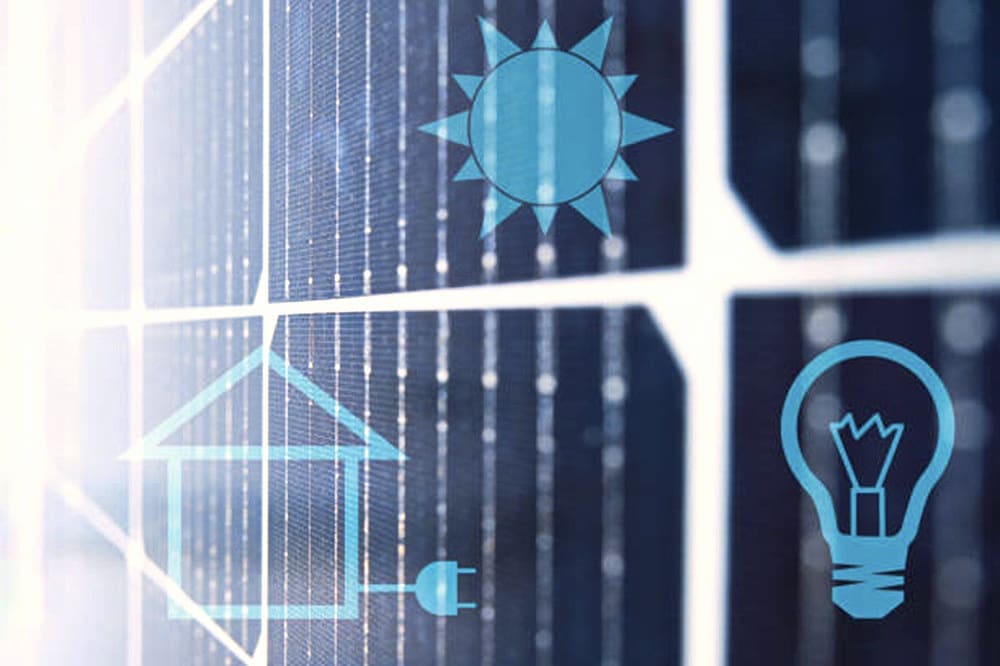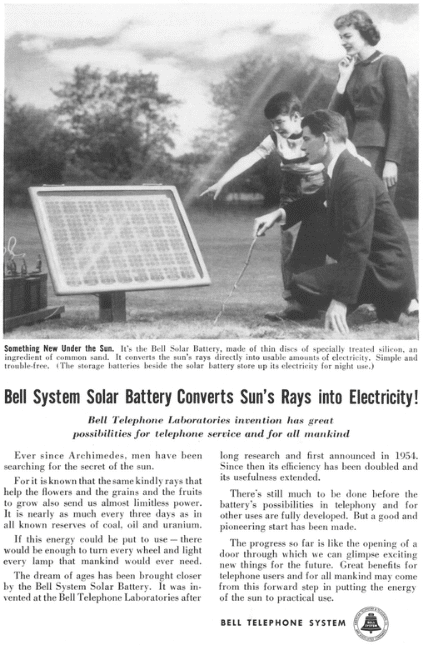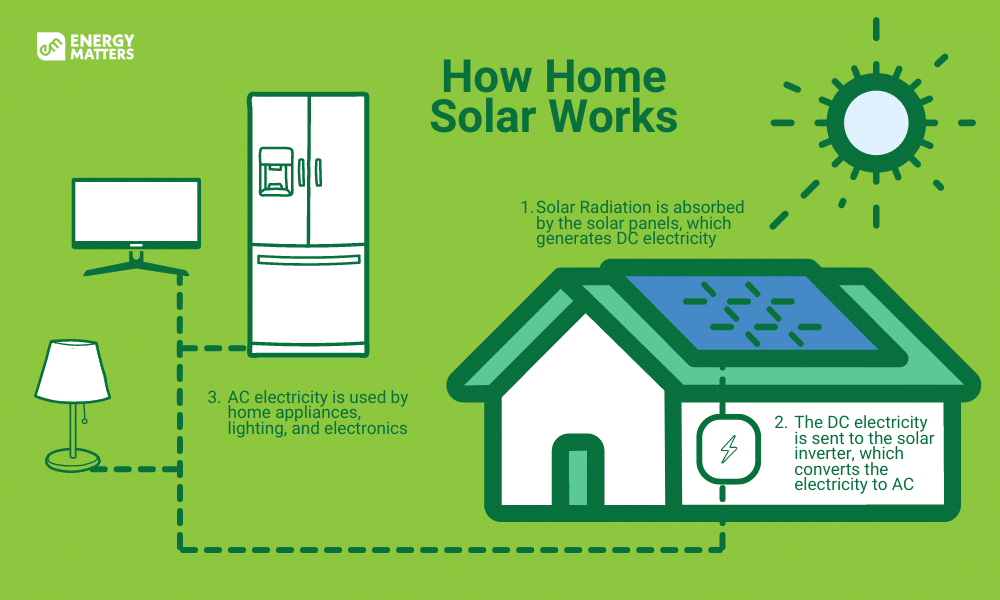
On this page
- A brief history of solar power
- How does solar energy work
- Types of solar energy
- How do solar panels work on a house
- Difference between solar PV panels and solar thermal panels
- Solar panel efficiency
- Benefits beyond the bills
- Using your solar panel system daily
- Unleash the potential of solar battery storage!
- FAQs
Understanding how do solar panels work is crucial as Australia’s uptake of rooftop solar is one of the highest in the world, with more than 30% of free-standing households across the nation now having a solar PV system installed.
While many of us understand the concept that solar power panels collect energy from the sun and convert it into electricity, few of us know exactly how they do this.
Below we take you through a brief history of solar power development before explaining how solar panels work.

A brief history of solar power
There are many early contributors to the development of the solar-powered technology we use today – so much so that the following summary won’t do them justice. However, it will provide some context to the development of solar power as we know it.
When was solar power discovered?
Historical records of using the sun as a source of energy date back as far as 3rd century BC, when the Greeks and Romans were known to harness solar power with mirrors to light torches for religious ceremonies. There is also evidence that ancient cultures considered solar orientation and passive heating in the construction of residential dwellings.
The sun’s potential as an energy source ignited in the 1830s with Alexandre Edmond Becquerel‘s discovery of the photovoltaic effect, the bedrock of solar technology. This revelation, followed by Augustin Mouchot’s visionary pursuit of solar engines in the 1860s, laid the groundwork for practical applications. Their solar-powered engines, precursors to modern parabolic dish collectors, even captured the imagination of Napoleon III.

Horace Bénédict de Saussure

Edmond Becquerel
Finally, in 1883, Charles Fritts’ creation of the first practical solar cell, using a selenium-gold coating, marked a turning point. Though its efficiency was modest, it proved the concept’s viability. The true leap came in 1954 with Bell Labs’ invention of a 4% efficient cell, the first capable of powering everyday devices. This sparked rapid progress, with Hoffman Electronics pushing efficiency to 8% in 1958 and 14% two years later. These early pioneers laid the foundation for the remarkable advancements in solar technology we witness today.

How does solar energy work
When installed on your rooftop, solar panels work by producing electricity through cells in these arrays. This happens through something called a photovoltaic effect, where the sunlight generates power in materials by knocking their external electrons.
The following is a breakdown of the process in more detail.
When light shines on a photovoltaic (PV) cell – also called a solar cell – that light may be reflected, absorbed, or pass right through the cell.

The PV cell is composed of semiconductor material. When the semiconductor is exposed to light, it absorbs the light’s energy and transfers it to negatively charged particles in the material called electrons. This extra energy allows the electrons to flow through the material as an electrical current. This current is extracted through conductive metal contacts – the grid-like lines on a solar cell – and then directed to your inverter (or micro-inverter – depending on what system you have). This source is then converted to AC electricity for your property to use.
The inverter installed on your property will always use the solar power you’ve produced first, only drawing excess electricity from the grid if it really needs it. Any extra energy you have created and don’t need will be sent through to the grid, with which you receive a nominated feed-in tariff.
When your system is installed, your retailer will install a ‘bi-directional’ meter that tracks all aspects of incoming and outgoing electricity from your array. Once you receive your bills, these will take into account the lesser amount of electricity you will need from the grid, plus any credits generated through what you produced and didn’t use.
Types of solar energy
There exist two primary forms of solar energy: photovoltaic (PV) solar and solar thermal.
Solar thermal energy is frequently integrated with other renewable energy sources to enhance the effectiveness of water heating. This integration is achieved through passive and active systems employing lenses, mirrors, or photovoltaic panels to concentrate solar energy in a specific location.
In contrast, solar photovoltaic cells have the capability to directly produce electricity from sunlight, often without requiring supplementary equipment such as inverters or battery storage systems.
How do solar panels work on a house
The journey from sunlight to your television isn’t quite that simple. Here’s the breakdown:
From panel to plug
- Sun soaks the panels: Sunlight hits the PV cells, exciting electrons and creating direct current (DC) electricity.
- DC to AC conversion: The DC electricity flows to an inverter, transforming it into alternating current (AC), used in homes and appliances.
- Grid or battery bound: The AC electricity can then either:
- Power your home: If the sun is shining and your energy needs are met, the AC electricity is used directly to run your appliances. Excess electricity can be sent back to the grid for credits.
- Charge your batteries: If you have a battery storage system, the AC electricity can be stored for use later, at night or during peak demand times.

Australian twists
Australia’s solar scene has unique features:
- Grid-connected systems: Most Australian homes have grid-connected solar systems. This means you can still access the grid when needed, and any excess solar power you generate can earn you credits from your electricity provider.
- Sunny advantages: Australia’s abundant sunshine and relatively high electricity costs make solar a particularly attractive option. Government rebates and incentives can further sweeten the deal.
- Battery boom: Battery storage is becoming increasingly popular, allowing homeowners to store their solar energy for later use and gain greater independence from the grid.
Difference between solar PV panels and solar thermal panels
The distinction between solar PV panels and solar thermal panels lies in their fundamental functionality and purpose.
Solar PV (photovoltaic) panels are designed primarily for electricity generation. These panels utilize semiconductors to directly convert sunlight into electrical energy.
On the other hand, solar thermal panels are focused on harnessing solar energy for heating purposes, typically water or air. These panels absorb sunlight and convert it into heat energy, which is then transferred to a fluid circulating through the system.
Solar PV Panels:
- Designed for electricity generation.
- Utilize semiconductors to directly convert sunlight into electrical energy.
- Operate based on the photovoltaic effect within the cells of the panel.
- Produce electricity suitable for powering various devices or stored in batteries.
Solar Thermal Panels:
- Primarily designed for heating purposes.
- Absorb sunlight and convert it into heat energy.
- Transfer the heat to a fluid circulating through the system.
- Used for hot water production, space heating, or industrial thermal processes.
Solar panel efficiency
The efficiency of a solar cell is determined by the amount of energy it can extract from the light source. This largely depends on the light’s characteristics, such as its intensity and wavelengths. Longer wavelengths have less energy and shorter wavelengths have more.
The “band gap” of a PV semiconductor is a key feature, determining which wavelengths of light it can absorb and convert to power. This will translate to a limited range of wavelengths, with the cell ignoring those that are longer and shorter. If the semiconductor’s band gap matches the wavelengths of light shining on the PV cell, it can efficiently make use of the available energy.
Solar cells have been specifically designed to absorb sunlight. A standard silicon solar cell responds to most of the visible parts of the sun’s light spectrum, roughly half of the infrared light, and a portion of the ultraviolet light (but not much of it, making UV lights some of the least efficient lights to charge a solar light with).
High-efficiency solar cells
To increase the efficiency of solar cells, there are multi-layer designs that mix the silicon with impurities, each with its own response curve. The top layer absorbs shorter wavelengths and the bottom converts the longer ones. The result is significantly better conversion efficiency and better energy output.
Benefits beyond the bills
Going solar offers more than just savings on your electricity bill. It also contributes to:
- Reduced carbon emissions: Solar power is a clean and renewable energy source, helping combat climate change.
- Increased energy security: Solar power reduces reliance on fossil fuels and imported electricity, boosting energy independence.
- Improved home value: Homes with solar panels sell faster and for higher prices.
Using your solar panel system daily
To get the most out of your array, there’s no need to turn it on in the morning or off at night. It will do its own thing to automatically power on and off when needed, so there’s no need for you to monitor it that closely. Additionally, you won’t experience any difference in how your home functions from the way these panels work – it’s subtle enough not to disrupt your lifestyle but significant enough to positively impact your ongoing electricity bills.
You’ll be able to view a number of details each day on your system, including how much electricity is produced in real-time, and the total since it began operation. Some inverters also have extensive reporting on other details, depending on the package you opt for.
Unleash the potential of solar battery storage!
Are you ready to transform the way you power your business or household? Say goodbye to rising electricity costs and unpredictable energy grids. The state-of-the-art solar battery systems empower you to maximise your energy efficiency, save money, and reduce your carbon footprint – all while enjoying an uninterrupted power supply.
Are you looking to save money on your electricity bills and reduce your carbon footprint? Solar energy is the perfect solution! Energy Matters can help you get up to 3 FREE solar quotes from pre-qualified and vetted solar firms in your area.
Energy Matters has been a leader in the renewable energy industry since 2005 and has helped over 40,000 Australian households in their journey to energy independence. With Energy Matters, you can be sure you're getting the best possible deal on solar energy. We only work with reputable solar firms with a proven track record of delivering high-quality solar systems.
Let us discuss and choose the best quote that suits your needs and budget, and we can connect you with our trusted local installers, who will provide up to 3 FREE quotes for your business solar and home battery system. Get your free quotes today!
FAQs
What are the benefits of solar energy?
The benefits of solar energy include clean and renewable power generation, reduced greenhouse gas emissions, and decreased reliance on fossil fuels.
Is solar power a clean energy source?
Yes, solar power is considered a clean energy source because it generates electricity without producing greenhouse gas emissions or other harmful pollutants.
Who are the largest producers of solar power worldwide?
China and the United States are the largest producers of solar power worldwide.









































